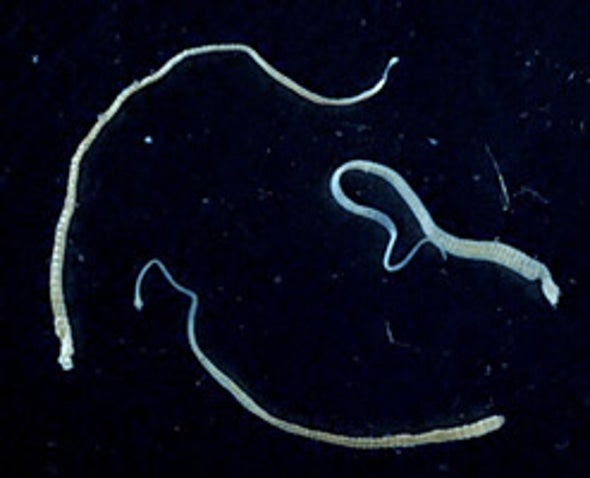
DAY TWENTY: HIRUNE NO MUSHI
("Afternoon Nap Bug")
Written by Jonathan Wojcik, Researched and Translated by Rev Storm

Thought to live in the space between the stomach and esophagus, this bug is described as "vine like" and resembling a centipede, but that its head and tail ends are indistinguishable. Its symptoms include difficulty swallowing and always taking an afternoon nap, which sound pretty inoccuous, but left untreated, this bug is said to be fatal!
Design Review:
A simple worm design, but this one feels as though it has defined segments, and the raggedy looking ends are quite unique.
TODAY'S REAL WORLD PARASITE:
Hymenolepis nana

Hirunenomushi feels like another obvious tapeworm, especially the way it looks "broken off" from a longer parasite, and we do in fact still have a number of tapeworm tales to tell, this one including a bizarre, terrifying and thankfully one-of-a-kind case.
Hymenolepis nana is one of the most common of all tapeworms to infect humans, and its life cycle is typical of the others we've discussed. Its genus is commonly referred to as the "dwarf" tapeworms, seldom growing more than a couple of inches in length as adults, and they are the tapeworms least likely to cause any noticeable symptoms. A major difference between them and the beef or pork tapeworm is that their larvae do not tunnel around encysting themselves in tissues, so we don't even have to worry about that much from the little fellas. Instead, their larvae hang out in the mostly fluid-filled bodies of tiny insects, such as flea larvae or grain beetles, waiting for the insect to be eaten by a rodent.
Humans can contract these by ingesting infected insects by accident, especially those grain beetles who might be hanging out in your cereal, but of course the insects can only become infected by the parasite if they've encountered eggs in the feces of some other infected creature. I should hope that if you have grain beetles in your cereal, they aren't simultaneously that close to poop.
Dwarf tapeworm infection is actually common enough that an estimated 25% of people, particularly children, are infected world-wide at any given time. That's one in four! It is luckily little more than a nuisance under most circumstances, and treatment is fairly accessible, inexpensive and quick.
Just one man was not so lucky, in a fluke sequence of events that will no doubt go down as one of history's most stunning medical oddities. His name has never been disclosed, but the 41 year old man was admitted to the Hospital in 2015 with a cough, fever and severe weight loss, not because of any parasites anyone had found yet, but because of highly aggressive tumors spreading throughout his lungs and lymph nodes.
It seemed like a cut-and-dry cancer case, until the biopsy was performed and the cancer's cells looked like none other the staff had seen, ten times smaller than any human cancer cells. It took DNA testing to determine their true nature - a genetic match with none other than the dwarf tapeworm, H. nana.
One reason cancer is typically so dangerous is that, by consisting of our own cellular matter, it isn't usually recognized as an intruder by our immune system, but parasites like tapeworms already have their own defenses against our immune response, and compounding this was the fact that the patient had been diagnosed with HIV ten years prior. These days, HIV is a fairly treatable condition, but he had apparently not been taking the medications he had been given, and his immune system had pretty much clocked out for good. When a tapeworm in his body developed a tumor, there simply wasn't anything to stop it from taking hold in the surrounding human cells, nor anything by then that could have hoped to slow its exponential growth.
Only 72 hours after the cancer was identified as having come from a flatworm, the patient was dead. Nothing like this case has ever been observed before and it is entirely possible that it will never be observed again, but any multicellular organism can develop cancer. Just because we only caught a single instance of a parasite passing cancerous tissue to its host, doesn't mean it's the only time this has happened, though it may very well be one of the only times it will have happened to a human that any of us will ever live to hear about.
NAVIGATION:









































































































